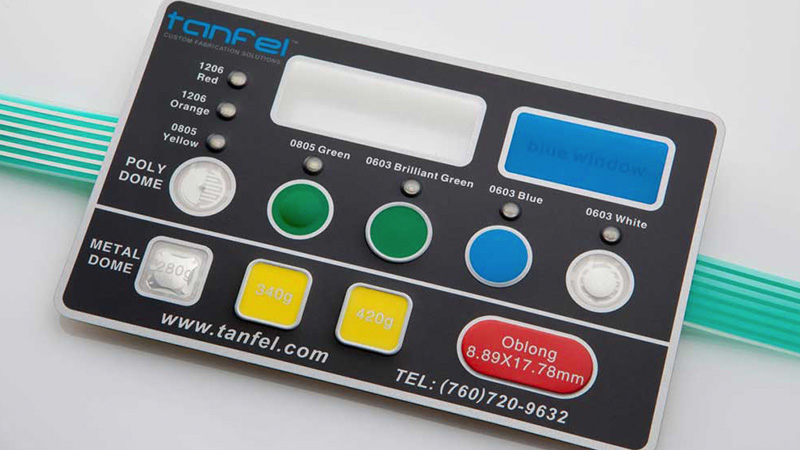Custom Membrane Switches for Specialized Applications: A Deep Dive
Custom Membrane Switches for Specialized Applications: A Deep Dive
Blog Article
Discover Just How Membrane Switches Function and Their Role in Modern Electronic Devices
Membrane Switches represent an innovative assimilation of innovation and design within the world of modern electronic devices, offering as vital interfaces in various devices. Comprehending the ins and outs of Membrane button performance and their more comprehensive implications in improving customer experience invites more exploration right into their style, benefits, and the innovative advancements forming their future in modern technology.
What Are Membrane Buttons?

Membrane switches are distinguished by their toughness and resistance to environmental variables, such as dirt, wetness, and severe temperatures. They can be customized with numerous graphics, colors, and responsive feedback alternatives, enhancing customer experience while maintaining visual allure - membrane switches. The incorporation of published circuits enables for seamless assimilation right into devices, enhancing overall performance.
The convenience of Membrane buttons is obvious in their capacity to support both straightforward and complex control features. They can incorporate functions such as LED indications and touch-sensitive technology, catering to certain user needs. As modern technology proceeds to evolve, Membrane Switches stay vital for enabling effective and intuitive user interfaces, thus playing a pivotal function in the innovation of modern-day electronic gadgets.
Components of Membrane Buttons
Membrane buttons are made up of several crucial components that interact to create a trusted and functional user interface. The primary components include the graphic overlay, adhesive layer, spacer layer, and conductive traces.
The visuals overlay functions as the interface, normally printed on a flexible substrate such as polyester or polycarbonate. This layer not just gives aesthetic allure but also consists of tactile comments, aesthetic cues, and safety features. Underneath the visuals overlay exists the glue layer, which safeguards the switch to the tool and makes sure durability against ecological stresses.
The spacer layer is essential for keeping the required space in between the visuals overlay and the circuit layer. This space enables for the activation of the switch when stress is applied. The conductive traces, normally made from silver or carbon, form the electrical paths that finish the circuit when the button is involved.
Additionally, a backing layer may be included for architectural assistance and insulation. These components collaborate seamlessly, guaranteeing that Membrane switches are both resistant and straightforward, making them important in various modern-day digital applications.
Just How Membrane Switches Work
Exactly how do Membrane Switches function properly within digital gadgets? Membrane Switches run on the principles of pressure-sensitive modern technology, utilizing a split building that includes graphic overlays, adhesive layers, and conductive components.
The layout of Membrane buttons is critical for their effective operation (membrane switches). The layers are diligently engineered to give tactile feedback, durability, and resistance to environmental aspects such as wetness and dirt. The inclusion of domes-- small, increased areas within the button-- boosts responsive response, providing customers with an obvious click sensation upon activation
Moreover, Membrane buttons can be tailored in regards to size, form, and graphics, making them suitable for various applications. They are commonly used in control panels, clinical gadgets, and customer electronic devices because of their streamlined style and reliability. In general, the efficient performance of Membrane switches is crucial in boosting individual interaction and making certain seamless procedure in contemporary digital tools.

Applications in Modern Gadgets
Utilizing their unique layout and performance, Membrane buttons have actually become important parts in a variety of modern electronic gadgets. These functional user interfaces are used in customer electronics, commercial tools, medical devices, and automotive controls, offering smooth individual communication.
In customer electronics, Membrane buttons are generally discovered in appliances like microwaves, cleaning machines, and other house devices, where they make site it possible for instinctive control with a smooth account. Their inconspicuous layout facilitates assimilation into compact gadgets, boosting aesthetic appeal without compromising capability.
In commercial applications, Membrane Switches function as control panels for machinery, using sturdiness and resistance to harsh environments. Their capacity to endure wetness and contaminants makes them excellent for use in production and processing industries.
Clinical devices also gain from Membrane buttons, which are made to be very easy to tidy and keep, guaranteeing health in clinical setups. They are usually used in diagnostic tools, patient monitoring systems, and mobile clinical devices, where integrity is critical.
Benefits of Membrane Buttons
Among the essential benefits of Membrane buttons is their adaptability, which permits them to be tailored for a selection of applications throughout multiple sectors. These buttons can be made in various forms and sizes, fitting one-of-a-kind product demands while providing seamless assimilation right into devices. Their thin profile allows a small and smooth layout, frequently boosting the visual charm of digital items.
An additional considerable benefit is their toughness - membrane switches. Membrane buttons are typically resistant to dust, wetness, and chemicals, making them optimal for extreme settings. This strength expands their life-span compared to conventional mechanical buttons, lowering the demand for regular substitutes
Furthermore, Membrane Switches deal cost-effectiveness. The manufacturing procedure entails printing innovations that decrease production prices, particularly for large runs. This price, incorporated with reduced maintenance demands, makes them an attractive option for producers.

Verdict
Finally, Membrane Switches stand for a significant innovation in customer interface technology within modern-day electronic devices. Their layered building and construction, pressure-sensitive procedure, and flexibility to numerous applications highlight their value across multiple markets. The resilience and ecological resistance of Membrane Switches even more boost their charm, making them a recommended selection for suppliers looking for dependable and adjustable services. these details As the demand for resistant and intuitive interfaces remains to expand, the duty of Membrane buttons in forming customer experience will most certainly broaden.
Membrane Switches stand for an innovative integration of technology and layout within the realm of contemporary electronics, offering as vital interfaces in many tools.In the world of contemporary electronics, Membrane Switches offer as vital parts that help with individual interaction with tools. As technology proceeds to advance, Membrane Switches continue to be necessary for allowing efficient and instinctive individual interfaces, therefore playing a critical role in the innovation of modern electronic devices.
Just how do Membrane Switches function Recommended Site efficiently within digital gadgets? Overall, the reliable functioning of Membrane switches is essential in enhancing customer interaction and making sure seamless operation in modern-day electronic tools.
Report this page